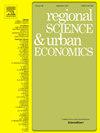Administrative areas and regional identity formation: The case of East Germany
IF 3.5
2区 经济学
Q1 ECONOMICS
引用次数: 0
Abstract
Changing regional administrative structures may have unintended consequences for citizens’ identification with their respective regions. We exploit a historical quasi-experiment to provide novel evidence on the formation of sub-national identities with changing administrative boundaries. During the German Reunification in 1990, federal states in East Germany were re-established. Some counties were located at the intersection of former GDR districts and historical federal states, creating uncertainty about their future state affiliation. Using a difference-in-differences approach, we show that in counties with initially unclear state affiliation, voter turnout in state elections after 1990 decreases by up to 2.5 percentage points. Turnout in national and local elections does not show significant difference. We argue that the uncertainty about their regional affiliation diminished citizens’ political engagement by undermining their identification with the federal state level.
行政区域与区域认同的形成:以东德为例
改变地区行政结构可能会对公民对各自地区的认同产生意想不到的后果。我们利用一个历史准实验来提供新的证据,证明随着行政边界的变化,次国家身份的形成。1990年两德统一期间,东德的联邦州重新建立。一些县位于前德意志民主共和国地区和历史上的联邦州的交汇处,这给它们未来的州归属创造了不确定性。使用差异中的差异方法,我们表明,在最初不明确州归属的县,1990年后州选举的选民投票率下降了2.5个百分点。全国和地方选举的投票率没有显著差异。我们认为,区域归属的不确定性削弱了公民对联邦州一级的认同,从而削弱了公民的政治参与。
本文章由计算机程序翻译,如有差异,请以英文原文为准。
求助全文
约1分钟内获得全文
求助全文
来源期刊

Regional Science and Urban Economics
Multiple-
CiteScore
5.30
自引率
9.70%
发文量
63
期刊介绍:
Regional Science and Urban Economics facilitates and encourages high-quality scholarship on important issues in regional and urban economics. It publishes significant contributions that are theoretical or empirical, positive or normative. It solicits original papers with a spatial dimension that can be of interest to economists. Empirical papers studying causal mechanisms are expected to propose a convincing identification strategy.
 求助内容:
求助内容: 应助结果提醒方式:
应助结果提醒方式:


